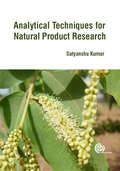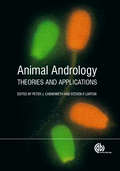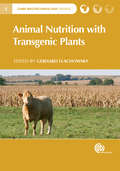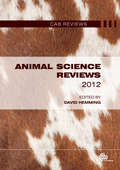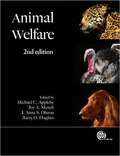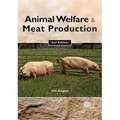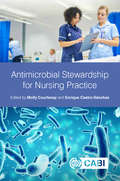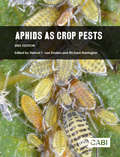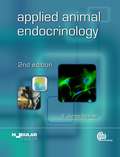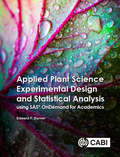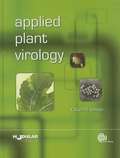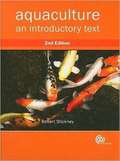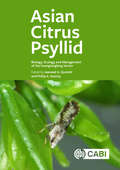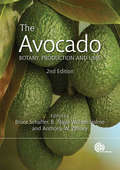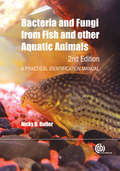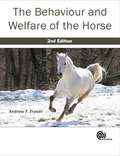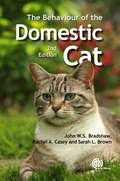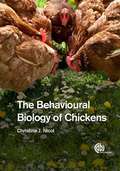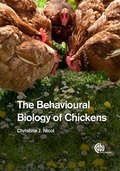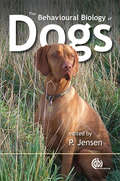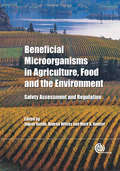- Table View
- List View
Analytical Techniques for Natural Product Research
by Satyanshu KumarPlants are important source of lead molecules for drug discovery. These lead molecules serve as starting materials for laboratory synthesis of drug as well a model for production of biologically active compounds. Phytochemical processing of raw plant materials is essentially required to optimize the concentration of known constituents and also to maintain their activities. Extraction techniques and analytical techniques have played critical roles in phytochemical processing of raw materials. Extraction technologies from conventional extraction to green extraction as well as analytical techniques from single technique to hyphenated/coupled techniques most frequently used in phytochemistry laboratories are covered in the book.
Animal Andrology
by William E William E Brian P Brian P Lefric Lefric Steven Lorton Francoise J Francoise J Julie A Julie A Erdogan Erdogan Bart M Bart M Sema Sema Abdullah Abdullah Clifford F Clifford F William L William L M Margaret V Margaret V Linda Linda Peter J Chenoweth Swanand SwanandUnderstanding animal andrology is fundamental to optimising genetic breeding traits in domestic and wild animals. This book provides extensive coverage of male reproductive biology, discussing the essentials of sperm production, harvest and preservation before covering the applications to a range of animals including cattle, horses, pigs, small ruminants, camelids, cats and dogs, poultry and exotic species. It also examines the laboratory procedures that provide the basis of general fertility research.
Animal Andrology: Theories and Applications
by Brian P Brian P William E William E Abdullah Abdullah Sema Sema Lefric Lefric Erdogan Erdogan Bart M Bart M William L William L M Linda Linda Francoise J Francoise J Margaret V Margaret V Julie A Julie A Swanand Swanand Clifford F Clifford FUnderstanding animal andrology is fundamental to optimising genetic breeding traits in domestic and wild animals. This book provides extensive coverage of male reproductive biology, discussing the essentials of sperm production, harvest and preservation before covering the applications to a range of animals including cattle, horses, pigs, small ruminants, camelids, cats and dogs, poultry and exotic species. It also examines the laboratory procedures that provide the basis of general fertility research.
Animal Nutrition with Transgenic Plants
by Tj Higgins Jie Wen Klaus Ammann Gerhard Flachowsky Yi Liu Ralf Einspanier Matin Qaim Atte Von Wright Agnes Ricroch Thomas Frenzel Marc De Loose Joachim Scholderer Emilio Rodriguez-Cerezo* Gathers together more than 150 feeding studies with food-producing animals and covers both first and second generation transgenic plants * The first central resource of this information for researchers, students and policy makers * Includes contributions from a wide range of specialists in the field
Animal Nutrition with Transgenic Plants (CABI Biotechnology Series #1)
by Marc De Loose Yi Liu Thomas Frenzel Agnes Ricroch Ralf Einspanier Atte Von Wright Emilio Rodriguez-Cerezo Jie Wen Matin Qaim Joachim Scholderer Tj Higgins Klaus Ammann* Gathers together more than 150 feeding studies with food-producing animals and covers both first and second generation transgenic plants * The first central resource of this information for researchers, students and policy makers * Includes contributions from a wide range of specialists in the field
Animal Science Reviews 2012
by David HemmingAnimal Science Reviews 2012 provides scientists and students with analysis of key topics in current research including breeding, animal behaviour, zoonotic diseases and environment. Experts such as Mike Stear, James France, Phillip Klesius and Frederick Silversides give essential overviews of their fields. Originally published online in CAB Reviews, this volume makes available in printed form the reviews in animal science published during 2012.
Animal Welfare
by Ignacio Viñuela-Fernández Georgia Mason Michael Cockram Paul Hemsworth Joy Mench Ilias Kyriazakis Linda Keeling Richard Bennett Marek Spinka Birte Nielsen Andreas Steiger Andrew Butterworth Peter Sandøe Francisco Galindo Michael Appleby Barry Hughes Paul Hocking Dominique Blache David Fraser Paul Thompson Alain Boissy Bryan Jones Anna OlssonThe welfare of animals continues to increase in recognition and concern throughout the world, with more and more research in the field offering new insights into the optimal conditions and treatment for the animals we live and work with. Providing a broad introduction to the key topics in the welfare of animals large and small, farm and companion, wild and zoo, this fully updated textbook covers ethics, animal pain and injury, health and disease and social conditions, welfare issues and problems, their assessment, and solutions. With contributions from renowned international experts Animal Welfare, 2nd Edition is an essential resource for students and researchers in animal and veterinary sciences.
Animal Welfare and Meat Production
by Temple Grandin Neville GregoryAnimal welfare issues are becoming increasingly prominent in animal production, for both economic and moral reasons. This book presents a clear understanding of the relationship between the welfare of major food animal species and their physiology, and the direct impact this has on meat quality. This new edition focuses on recent research and developments and also looks into welfare in aquaculture.
Antimicrobial Stewardship for Nursing Practice
by Briette Du Toit Yolanda Van Zyl Maria Clara Padoveze Ligia Maria Abraão Rosely Moralez Figueiredo Jo McEwen Heather Kennedy Nykoma Hamilton Emma Burnett Valerie Ness Fiona Gotterson Prof Elizabeth Manias Rose Gallagher Rita Olans Susie Singleton Joanne BosanquetDrug-resistant infections are one of the greatest threats to human health, and with resistance on the rise, appropriate antimicrobial stewardship (AMS) is more important than ever. This book, written by nurses for nurses, provides a clear and concise approach to good practice in this vital area. Exploring all aspects of AMS, this new book is underpinned by a competency framework endorsed by scientific and professional societies, including the National Institute for Health and Care Excellence (NICE). It explains the practices that ensure optimal use of antibiotics for the best clinical outcome, with both minimal toxicity to the patient and minimal impact on subsequent antimicrobial resistance. This book, the first applied directly to antimicrobial stewardship for nurses, supports standards of proficiency for registered nurses, and can therefore be used by regulators and professional bodies to inform standards of proficiency and guidance. The book covers infection prevention and control, antimicrobial resistance, diagnosis of infection and appropriate antimicrobial use, patient engagement, collaboration between professions and how to implement AMS in nursing practice. Including learning tools such as objectives, practical case studies and questions throughout, as well as lecture slides, this book is an essential read for undergraduate nursing students and specialist nurses worldwide. This book is authored by a multi-national group of experts with representation from professional associations, universities and national public health agencies, such as: - Royal College of Nursing, UK - Cardiff University, UK - University of São Paulo, Brazil - Public Health England, UK - National Centre for Antimicrobial Stewardship, Australia
Aphids as Crop Pests
by Helmut F. Emden Richard HarringtonAphids are among the major global pest groups, causing serious economic damage to many food and commodity crops in most parts of the world. This revision and update of the well-received first edition published ten years ago reflects the expansion of research in genomics, endosymbionts and semiochemicals, as well as the shift from control of aphids with insecticides to a more integrated approach imposed by increasing resistance in the aphids and government restrictions on pesticides. The book remains a comprehensive and up-to-date reference work on the biology of aphids, the various methods of controlling them and the progress of integrated pest management as illustrated by ten case histories. Helmut van Emden is Emeritus Professor of Horticulture at the University of Reading, UK. He has researched on aphids for over 50 years and has wide international experience, including in the tropics. Richard Harrington retired in 2015 as Head of the Rothamsted Insect Survey, with which he worked for 36 years on aphid monitoring and forecasting. He led the EU project "EXAMINE" (Exploitation of Aphid Monitoring In Europe) which brought together colleagues involved in aphid monitoring throughout Europe and beyond.
Applied Animal Endocrinology
by E. James SquiresThis textbook explains the role of hormones in improving and monitoring the production, performance, reproduction, behaviour and health of animals. With its focus on livestock animals: cattle, pigs, sheep and horses as well as poultry and fish; the book uses an integrative approach to cover endocrine concepts across species. This updated edition is expanded to include new topics in each section, with updated references, revised study questions and an expanded subject index. It is an essential text for students in animal and veterinary sciences as well as those in academia and industry that are interested in applications of endocrinology in animal production systems. Praise for the first edition: '...a useful text for teaching purposes and an important reference for those who seek ready access to information on specific aspects of applied endocrinology.' Poultry Science
Applied Plant Science Experimental Design and Statistical Analysis Using SAS® OnDemand for Academics
by Associate Profes Edward DurnerThe correct design, analysis and interpretation of plant science experiments is imperative for continued improvements in agricultural production worldwide. The enormous number of design and analysis options available for correctly implementing, analysing and interpreting research can be overwhelming. SAS® is the most widely used statistical software in the world and SAS® OnDemand for Academics is now freely available for academic institutions. This is a user-friendly guide to statistics using SAS® OnDemand for Academics, ideal for facilitating the design and analysis of plant science experiments. It presents the most frequently used statistical methods in an easy-to-follow and non-intimidating fashion, and teaches the appropriate use of SAS® within the context of plant science research. This book: - Covers experimental designs and data analysis protocols - Is presented as a how-to guide with many examples - Includes freely downloadable data sets - Examines key topics such as merging data frames, multivariate analysis and linear regression Authored by an experienced teacher of applied plant science statistics, this book assumes no prior background in statistics and guides users through the appropriate methodologies in research. It is an invaluable tool for advanced undergraduate and graduate students, in addition to researchers, extension consultants, faculty and technicians.
Applied Plant Virology
by Calum Rae WilsonWritten for advanced undergraduate students, this book is a practical, in-depth guide to plant virology. Beginning with an introduction to viruses and their classification, the text describes virus pathology, including how viruses enter and move through plant cells and induce disease. Subsequent chapters discuss how viruses spread in the field and how to measure this. Throughout, the book remains reader-friendly, using focus boxes for clear, easy to obtain information, enabling students to quickly access relevant information but supply sufficient detail for advanced studies. In addition to basic information on virus biology there is an additional focus on applied virology, ideal for students undertaking agricultural studies for whom study of disease and its control is essential.
Aquaculture
by Robert R StickneyProviding a broad and readable overview of the subject, this updated second edition of Aquaculture: An Introductory Text covers issues associated with sustainable aquaculture development, culture systems, hatchery methods, nutrition and feeding of aquaculture species, reproductive strategies, harvesting, and many other topics. While its main focus is on the culture of fish, molluscs, and crustaceans for food, the book also covers other forms of aquaculture, such as the production of seaweeds, recreational fish and ornamental species, and live foods such as algae and rotifers that are used to feed larval shrimp and marine fish. Printed in a new, larger format and illustrated with many photos and diagrams, this will be an essential resource for undergraduate students of aquaculture and related topics. The scope is global and much of the information is based on first-hand experiences of the author.
Asian Citrus Psyllid: Biology, Ecology and Management of the Huanglongbing Vector
by Sandra A Allan Sidney Altman Antonio Juliano Ayres El-Desouky Ammar George A Beattie Michael J Boyle Liliana Cano Joseph M Cicero Sasha-Kay V Clarke ELIZABETH E GRAFTON-CARDWELL Susan Halbert David G Hall Michelle Heck Chris S Holland Wayne B Hunter Richard W Mankin Greg Mccollum Jackie L Metz Godfrey Miles Marcelo Pedreira Miranda Cesar Monzo Thomson M Paris K S Pelz-Stelinski Barukh Rohde Andres F Sandoval-Mojica Mamoudou Sétamou Robert G Shatters Jr Burton Singer John M TomichAsian citrus psyllid (ACP), Diaphorina citri, is an insect pest which transmits a bacterium, Candidatus Liberibacter asiaticus (CLas), primarily through feeding in newly emergent foliage of citrus trees. This pathogen causes a disease known as Huanglongbing (HLB), or citrus greening, which has become the most debilitating and intractable disease in citrus crops. This book, written by a team of experts on the Asian citrus psyllid, gathers together everything currently known about the biology and ecology of this important pest species, examines the transmission and acquisition processes of the pathogen, and looks at current management practices and their effectiveness. The potential for new, innovative management techniques are also described, along with the economic implications of managing this rapidly establishing disease. This book: Covers all aspects of Asian citrus psyllid biology and ecology for the first time in one place. Examines new, innovative management practices and assesses their effectiveness. Discusses the vector-pathogen relationship in detail. Explains the economics of controlling this devastating pest. This title is essential reading for all researchers involved in the management and control of Asian citrus psyllid, extension agents, and pest management consultants. It will also be of great use to graduate students in applied entomology and related disciplines.
Avocado
by Anthony W Whiley Jonathan Crane André Ernst Carlos Balerdi Alejandro Barrientos Priego Mary Arpaia Ben Faber Rodrigo López-Gómez Uri Lavi Elizabeth Dann Andre Chanderbali Pilar Gil Lindy Coates Bruce Schaffer Mark Hoddle Edward Evans Derek Donkin Carol Lovatt Greg Douhan Peter Hofmann Emanuel Lahav Victor Albert John Bower Jay Bost Richard Litz Martín Aluja Lauren Garner Araceli Barceló-Muñoz Gary Bender B Nigel WolstenholmeAlthough avocado has been cultivated and consumed for more than 9000 years near its centre of origin in Latin America, world production and trade has increased dramatically over the past few decades. The avocado is now a widely traded fruit between warmer and colder countries as a result of the global community becoming increasingly aware of the versatility and nutritional value of this crop. For the past decade, the world avocado industry has been going through a period of rapid technological change and innovation. The dietary value of "the most nutritious of all fruit" is also receiving more attention. This fully updated new edition of the successful 2002 book will provide a comprehensive review of avocado production, science and technology.
The Avocado: Botany, Production and Uses (Botany, Production and Uses)
by Victor Albert Martín Aluja Mary Arpaia Carlos Balerdi Araceli Barceló-Muñoz Alejandro Barrientos Priego Gary Bender Jay Bost John Bower Andre Chanderbali Lindy Coates Jonathan Crane Elizabeth Dann Derek Donkin Greg Douhan André Ernst Edward Evans Ben Faber Lauren Garner Pilar Gil Mark Hoddle Peter Hofmann Emanuel Lahav Uri Lavi Richard Litz Rodrigo López-Gómez Carol LovattAlthough the avocado has been cultivated and consumed for more than 9000 years in its native Latin America, world production and trade have only developed over the past few decades, and now exceed 3.5 million tonnes. The avocado is now widely traded between warmer and colder countries as a result of the global community becoming increasingly aware of its versatility and nutritional value. For the past decade, the global avocado industry has been going through a period of rapid technological change and innovation. The dietary value of 'the most nutritious of all fruit' is also receiving more attention.
Bacteria and Fungi from Fish and Other Aquatic Animals
by Nicky BullerThis practical book provides an updated resource for the identification of bacteria found in animals inhabiting the aquatic environment, illustrated with colour photos. It contains expanded biochemical identification tables to include newly identified pathogenic and saprophytic bacteria, molecular identification tests now available for a greater number of aquatic bacterial pathogens, more information on the pathogenesis and virulence of each organism and new coverage of traditional and molecular identification of fungal pathogens and quality assurance standards for laboratories.
Bacteria and Fungi from Fish and Other Aquatic Animals: A Practical Identification Manual
by Nicky BullerThis practical book provides an updated resource for the identification of bacteria found in animals inhabiting the aquatic environment, illustrated with colour photos. It contains expanded biochemical identification tables to include newly identified pathogenic and saprophytic bacteria, molecular identification tests now available for a greater number of aquatic bacterial pathogens, more information on the pathogenesis and virulence of each organism and new coverage of traditional and molecular identification of fungal pathogens and quality assurance standards for laboratories.
Behaviour and Welfare of the Horse
by Andrew FraserHorses play a unique role in human activities, for both work and recreation. From the ranch to the racetrack, an understanding of their behaviour and needs is vital for man to ensure their well-being. Providing a comprehensive, scientific overview of horse behaviour and its relation to welfare, this new, updated edition includes new developments in the understanding of the relationship between physiology and performance, and the neuro-chemical basis of stereotypic behaviour. It is expanded to address the important topic of welfare from both a fundamental and practical viewpoint, and will serve as an essential resource for veterinarians, equine professionals and horse owners as well as students of veterinary and animal sciences.
Behaviour of the Domestic Cat, 2nd edition
by Sarah Brown Rachel Casey John BradshawThe behaviour of domesticated animals is a subject of great importance to students of animal behaviour and veterinary medicine, as well as interested pet owners. This book presents an engaging overview of the behaviour of the domestic cat, adopting both a mechanistic and functional approach. Physiological, developmental and psychological aspects are addressed, including domestication, the development of the senses, learning, communication and feeding behaviour. The authors build on these themes to discuss social behaviour, hunting and predation, cat-human interactions and welfare. Fully updated throughout, this new edition also includes two new chapters on behavioural disorders due to pathologies and from misdirected natural behaviour. It is an essential source of cat behaviour information for students, ethologists, veterinarians and pet owners.
The Behavioural Biology of Chickens
by Christine NicolChickens are by far the world's most widely farmed animal, kept for both meat and egg production. They are at the centre of many debates regarding housing and production systems, causing significant interest in what lies behind chicken behaviour. This accessible book covers sensory biology, behavioural development, preferences and aversions, social behaviour, learning and cognition, behavioural issues in different systems and solutions for behavioural problems. Authored by an authority on chicken ethology, it brings together the fields of animal behaviour, neuroscience, psychology and epidemiology to provide a comprehensive understanding of chicken behaviour and help improve the lives of farmed chickens around the world.
Behavioural Biology of Chickens, The
by Christine NicolChickens are by far the world’s most widely farmed animal, kept for both meat and egg production. They are at the centre of many debates regarding housing and production systems, causing significant interest in what lies behind chicken behaviour. This accessible book covers sensory biology, behavioural development, preferences and aversions, social behaviour, learning and cognition, behavioural issues in different systems and solutions for behavioural problems. Authored by an authority on chicken ethology, it brings together the fields of animal behaviour, neuroscience, psychology and epidemiology to provide a comprehensive understanding of chicken behaviour and help improve the lives of farmed chickens around the world.
Behavioural Biology of Dogs
by Per JensenWritten by experts in different areas, this book presents an up-to-date account of the behavioural biology of dogs. Split in 3 parts, the book addresses the specific aspects of behavioural biology. The first part deals with the evolution and development of the dog, whereas the next part deals with basic aspects of dog behaviour. The final part emphasises on the behavioural problems, their prevention and cure.
Beneficial Microorganisms in Agriculture, Food and the Environment
by Stephen Jaronski Carl-Gustaf Thornstrom Andrea Wilcks Keith Warner Ingvar Sundh Stephen Wessels Avrelija Cencic Milton Typas Barbara Pernfuss Roland Mollby Niels Hendriksen John Howieson Rudiger Hauschild Peter Van Baarlen Anne Madsen Michael Frodyma C Kurz Claude Alabouvette Mark Goettel Trudy Wassenaar Atte Von Wright Jeroen Meussen Harry Evans Gregorio Loprieno Andrew Chesson Michael WisniewskiMicroorganisms are widely used in various beneficial applications, including food, pest control, bioremediation, biodegradation, biofuel processes, and plant symbiosis and growth stimulation. his book provides an overview of the available methodology for safety assessments of microorganisms, including determination of their infectivity and whether they produce toxic or sensitising substances. Also covered are the regulatory systems in risk assessment and management of microbial products, quarantine legislations, international treaties, the importance of public risk perception and risk reduction behaviour.
